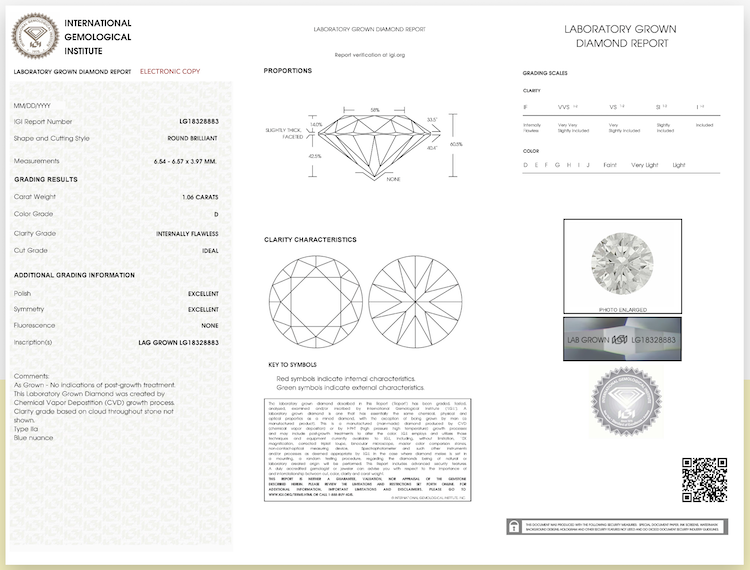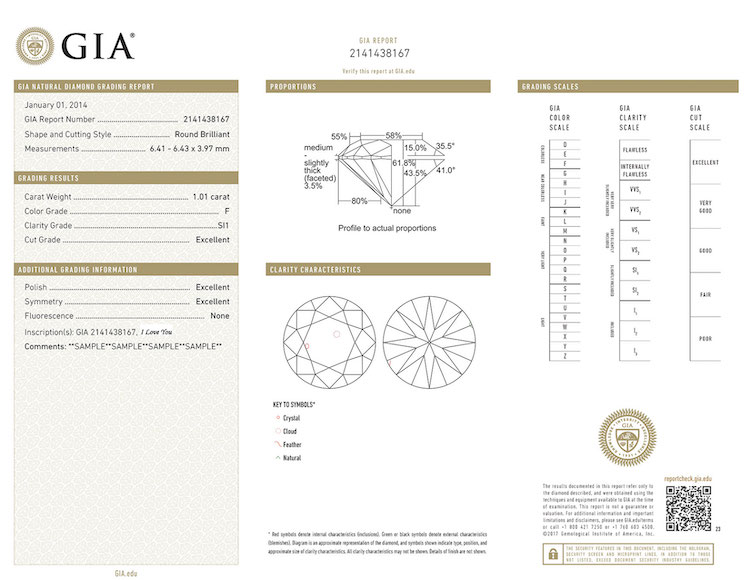Diamond Education
IGI Certification
When it comes to diamond certification, the International Gemological Institute (IGI) is a name that you're likely to come across alongside the likes of the Gemological Institute of America (GIA). Founded in 1975, IGI has grown to become the world's largest independent laboratory for testing and grading gemstones and fine jewelry. While GIA often takes the spotlight in discussions around diamond certification, IGI has carved out a significant niche for itself in the gemological world, particularly with its work in grading lab-grown diamonds.
Summary:
- Understanding IGI Certification
- The IGI Diamond Grading Process
- How to Read an IGI Diamond Certificate
- Comparing IGI with Other Diamond Labs
- The Value of IGI Certification
- Conclusion
Understanding IGI Certification
An IGI certification is a detailed report on the quality of a diamond, created by a team of experienced and trained gemologists. This report provides a comprehensive analysis of the diamond's 4Cs - Carat, Color, Clarity, and Cut - and assesses additional characteristics like symmetry and fluorescence.
The IGI's team follows a meticulous process to evaluate each diamond, using advanced technology and techniques to ensure an unbiased assessment. This thorough process has led to IGI's recognition as one of the most trusted names in diamond grading.

For lab-grown diamonds, IGI has emerged as a leader in the field. Their rigorous grading process, combined with a deep understanding of the unique characteristics of lab-grown diamonds, ensures that every IGI-certified lab-grown diamond meets stringent quality standards. This has made IGI certification a valuable asset for anyone considering a purchase in the burgeoning market of lab-grown diamonds.
The IGI Diamond Grading Process
The IGI Diamond Grading Process is a comprehensive procedure that thoroughly assesses a diamond's quality based on a range of factors. This intricate process is what has allowed IGI to become a trusted name in the gemological world, particularly for lab-grown diamonds.
The process begins with an initial examination of the diamond. Here, gemologists check the diamond's overall condition, looking for any chips or damage that could affect its value or grading. This stage is crucial for understanding the overall physical state of the diamond before diving deeper into its attributes.
Next, the diamond's weight is accurately measured using highly sensitive scales. This step is crucial for determining the diamond's carat weight, one of the four Cs that significantly influence a diamond's value.
Once the initial examination and weight determination are complete, the diamond's color and clarity are graded. IGI follows its own detailed scales for color and clarity grading, which slightly differ from other labs like GIA. The color grading evaluates the presence of any color in the diamond, with a scale ranging from D (colorless) to Z (light yellow or brown). The clarity grade, on the other hand, assesses the presence of internal and external flaws, or inclusions and blemishes, respectively.
The evaluation of a diamond's cut is another critical part of the IGI grading process. This is where the diamond's proportions, symmetry, and polish are assessed. The cut grade is crucial because it directly influences how well a diamond interacts with light, affecting its brilliance, fire, and scintillation.
For lab-grown diamonds, IGI has developed specific protocols to identify and grade these gems accurately. This includes the use of advanced technology to distinguish lab-grown diamonds from their natural counterparts and a detailed assessment of their quality attributes.
Finally, the results of the grading process are compiled into a comprehensive report. This report provides a detailed analysis of the diamond's 4Cs and additional features, offering a complete picture of its quality.
How to Read an IGI Diamond Certificate
An IGI Diamond Certificate, also known as a diamond report, is a document that provides a detailed description of a diamond's attributes. It can be seen as a blueprint of a diamond's quality and authenticity.
Here's how to read and understand it:
Report Number: At the top of the certificate, you'll find a unique report number assigned to that particular diamond. This number can be used to verify the report's authenticity on the IGI website.
Shape and Cutting Style: This section describes the diamond's shape (e.g., round, princess, pear) and cutting style (e.g., brilliant, step cut).
Measurements: This section provides the diamond's physical dimensions in millimeters. For round diamonds, it will give the minimum and maximum diameters and the depth. For fancy shapes, it will provide the length, width, and depth.
Grading Results: Here, you'll find the diamond's 4Cs - Carat Weight, Color, Clarity, and Cut. The carat weight is the diamond's size, the color grade assesses the presence or absence of color, the clarity grade evaluates the presence of internal or external flaws, and the cut grade reflects the quality of the diamond's proportions, symmetry, and polish.
Additional Grading Information: This section provides details on the diamond's polish, symmetry, and fluorescence. Polish refers to the quality of the diamond's surface condition, symmetry assesses the alignment and balance of the diamond's facets, and fluorescence refers to the diamond's reaction to UV light.
Comments: This section includes additional information about the diamond that doesn't fit into other categories. It may contain information about inscriptions on the diamond, if any, or notable characteristics.
Diamond Plot: This is a graphical representation of the diamond's clarity characteristics. It's essentially a map of the diamond's internal and external inclusions, which helps in identifying the diamond.
Proportions Diagram: This is a visual illustration of the diamond's proportions, including its table and depth percentages, and the angles of its crown and pavilion.
To verify the information on an IGI Diamond Certificate, you can use the Report Check feature on the IGI website. This allows you to match the certificate number with the information held in the IGI's database, confirming the report's authenticity.
Comparing IGI with Other Diamond Labs
When comparing the International Gemological Institute (IGI) with other diamond grading labs, it's crucial to remember that the IGI is one of the largest independent gem labs in the world and is renowned for its reports on lab-grown diamonds.
The Gemological Institute of America (GIA), for instance, is often considered the most highly regarded grading lab worldwide and is known for its rigorous diamond assessment systems. Established in 1931, the GIA is a nonprofit organization that is acclaimed for its gem research and reports on natural diamonds. The GIA is also responsible for developing the universally accepted Four Cs diamond grading standards.

However, while the GIA's standards are known to be the strictest among all grading institutions, it's important to note that this strictness does not necessarily equate to superiority. While the GIA may grade a diamond's color, clarity, or cut lower than the IGI might, this doesn't mean the IGI is applying looser standards. The subjective nature of grading means there are no objective criteria for where a diamond's color, cut, and clarity land on the scale. Expert gemologists at both the IGI and GIA compare the diamond to a given standard and decide where it lands. Despite these grading differences, one constant remains: carat weight is objective and will be the same no matter which lab grades the diamond.
Perhaps the most significant distinction between the IGI and other labs like the GIA is that the IGI has gained substantial respect within the industry for its work with lab-grown diamonds. Being the first major organization to certify the color and cut of lab-grown diamonds, the IGI's reports on these diamonds are nearly identical to their reports for natural diamonds. This expertise has led to many lab-grown diamonds at popular retailers like James Allen being certified by the IGI.
The Value of IGI Certification
The value of an IGI certification stems from the institute's commitment to providing detailed, comprehensive, and reliable assessments of a diamond's characteristics. This certification serves as a guarantee to consumers, diamond dealers, and jewelry retailers about the quality and authenticity of the diamond in question.
One of the main reasons the IGI certification is valued in the market is due to the institute's stringent grading process. The IGI uses advanced technology and highly trained gemologists to assess each diamond based on the universally accepted Four Cs - Carat, Color, Clarity, and Cut. This meticulous process ensures an unbiased evaluation of the diamond's quality.
Another significant aspect of the IGI's value lies in its expertise in grading lab-grown diamonds. As the first major organization to certify the color and cut of lab-grown diamonds, the IGI has carved out a niche in the diamond industry. This specialization has led to a rise in the demand for IGI certification, particularly from dealers and consumers of lab-grown diamonds.
Moreover, IGI's certification also includes a detailed analysis of the diamond's proportions and a plotted diagram of its clarity characteristics, providing a comprehensive overview of the diamond's quality. This transparency and thoroughness in reporting help buyers and sellers make informed decisions.
Finally, an IGI certificate is recognized worldwide, making buying or selling diamonds internationally easier. As a result, diamonds certified by the IGI often command higher prices in the market compared to diamonds without certification or with certification from less recognized labs.
In summary, the value of an IGI certification lies in its meticulous grading process, expertise in lab-grown diamonds, comprehensive reporting, and global recognition. It serves as a reliable guide for buyers and sellers, providing assurance about the quality and authenticity of a diamond.
Conclusion
Understanding diamond certification is key when purchasing a diamond. Among the many reputable grading laboratories, IGI has made significant contributions to the field, particularly with its work with lab-grown diamonds. As you embark on your journey to find the perfect diamond, consider the benefits of IGI-certified diamonds, especially if you're interested in lab-grown options. Happy diamond shopping!
